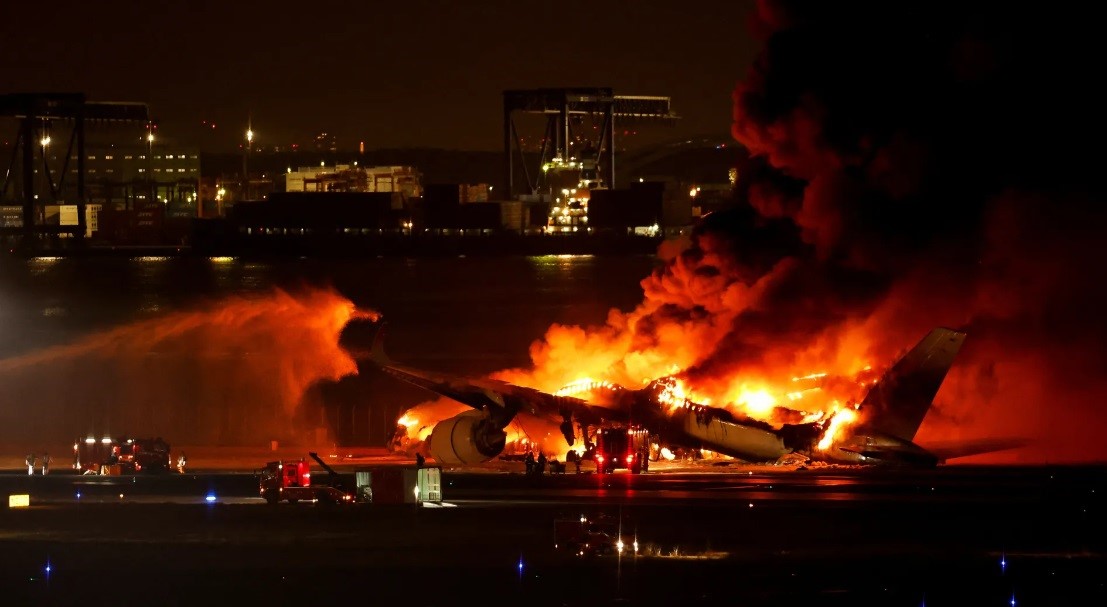

In the recent aviation incident at Tokyo's Haneda airport involving the Japan Airlines Airbus A350, the resilience of the aircraft's composite structure, comprising 53% composite materials, has come into sharp focus. The collision with a smaller plane resulted in a fierce blaze, marking the first complete destruction by fire of an airliner primarily made from carbon fibre.

The fact that all 379 people onboard managed to escape is a testament to the effectiveness of modern aircraft materials and evacuation procedures.
The head of consultancy and news site Leeham News, Scott Hamilton, declared: "The JAL A350 is the first hull loss of a composite airliner and the first by fire. Investigators will learn all kinds of lessons from the A350 accident."
The application of composite materials, like carbon fibre, has become increasingly prevalent in the aerospace industry, driven by the pursuit of weight reduction and enhanced fuel efficiency. However, the incident has prompted discussions on the safety implications of such materials, particularly in the context of fire emergencies.
It's noteworthy that the Airbus A350 incident involved a model made largely from carbon fibre, which, unlike traditional aluminium, has a lower melting point. In contrast, aluminium, with its higher melting point of about 600 degrees Celsius, offers a natural advantage in terms of fire resistance. While aluminium has been a staple in aviation for years, its significance in mitigating risks associated with high-temperature scenarios is underscored by this incident.
Ed Galea, a Greenwich University professor from London specialising in fire safety, commented: "It was a good outcome, but the evacuation scenario was high risk." He pointed out that the plane's nose was also tilted southwards, making it difficult to access the inflatable slides. "In these circumstances, every second counts," Ed remarked.
The burning A350 showcased the robustness of its composite structure, which demonstrated an ability to withstand heat for an extended period. However, it raises questions about whether the higher melting point of aluminium could potentially have lessened the risk factor in such a scenario. Aluminium's ability to resist extreme temperatures and its proven track record in aviation safety should be acknowledged.
Though the aircraft blueprint is under complete scrutiny, an aeronautical engineer, who is an analyst at Leeham News, Bjorn Fehrm, asserted: "The most important part, whether the plane is aluminium or carbon fibre, is that you have protection for many, many minutes from external heat. In this case, the carbon fibre is giving that heat-shield protection."
While composite materials are known for their strength and lightweight properties, the incident highlights the importance of considering the trade-offs, especially in the realm of fire safety. As aviation continues to evolve, the debate between the use of aluminium and composite materials gains renewed significance, emphasising the need for a balanced approach that prioritises both weight efficiency and safety.
Emile Greenhalgh, professor of composite materials at Imperial College in London, further clarified: "As the material burns, all the flammable material forms a char layer . . .(so) you end up with a barrier against the progression of fire."
It is safe to say that the incident involving the Japan Airlines Airbus A350 underscores the critical role materials play in aviation safety. While composite structures offer advantages, including weight reduction, the higher melting point of aluminium remains a compelling factor in mitigating risks associated with fire emergencies. The aviation industry must carefully weigh the benefits of advanced materials against their potential drawbacks, ensuring a harmonious balance between innovation and safety.
To learn more about the use of aluminium in the automobile sector, please spare some time on AL Circle's special report, Future of Aluminium in Transportation Sector.
Responses








